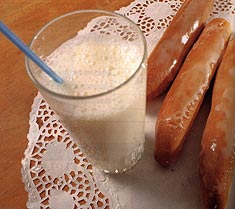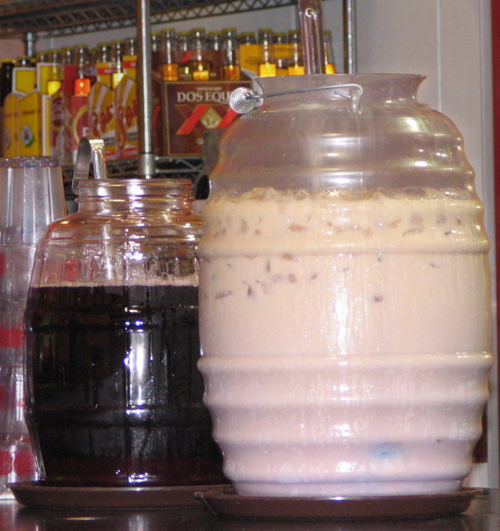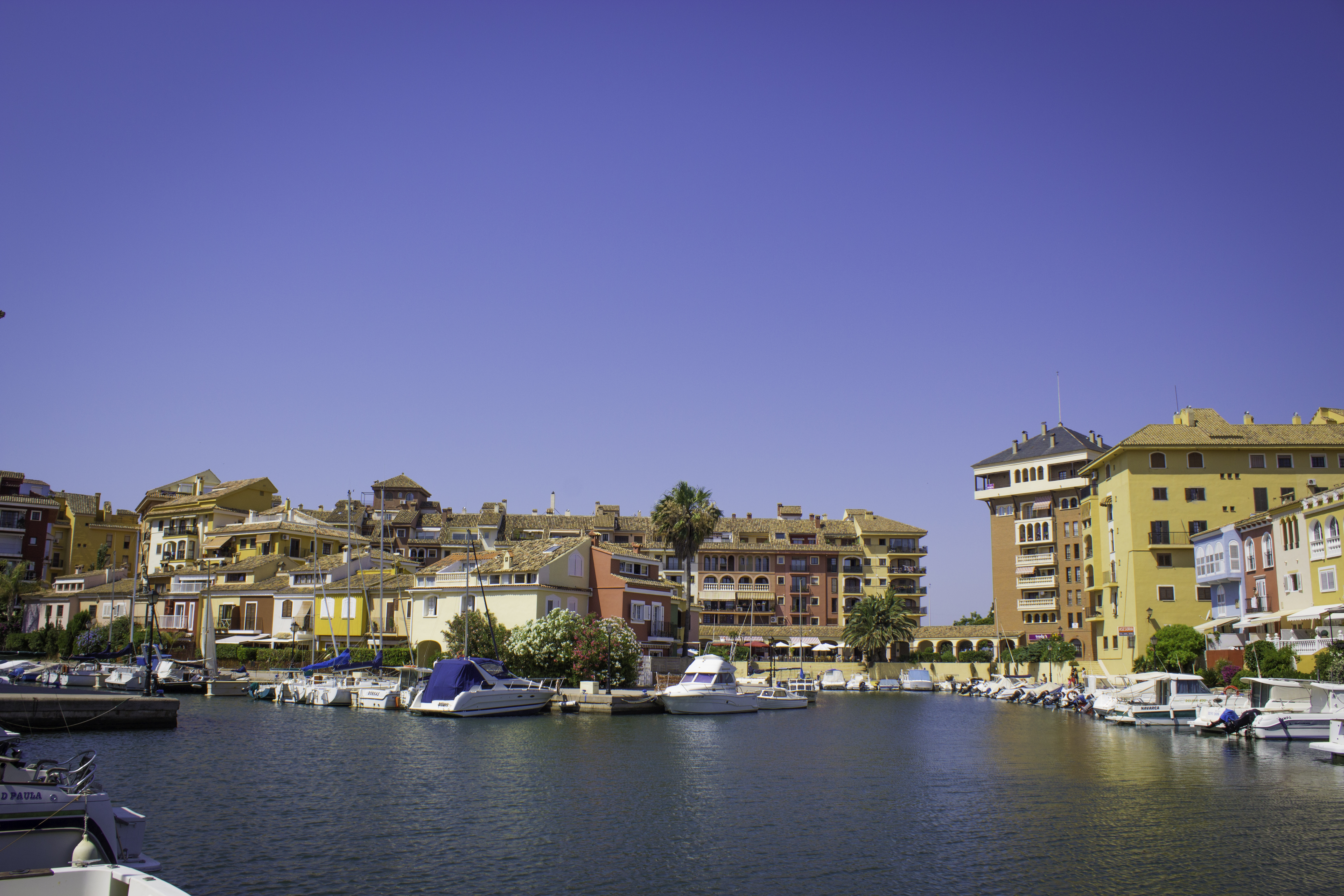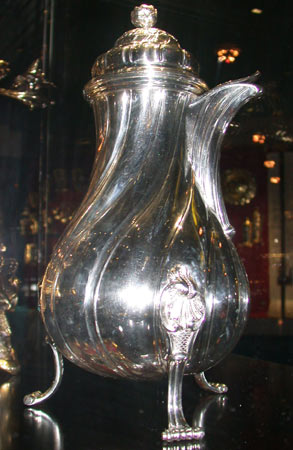|
Fartons
Fartons (, plural. es, fartón) are confectionery sweets typical of the Valencian town of Alboraia, Spain. Elongated and glazed with sugar, they are made of flour, milk, sugar, oil, eggs, and a leavening agent. This delicate and spongy sweet is made for dipping in orxata or horchata, a drink made of tigernuts that is served cold. Fartóns are also eaten with hot beverages such as hot chocolate or caffè latte. Origin According to an apocryphal legend, James I of Aragon called the drink orxata "pure gold" because of its texture and sweetness. In the 1960s, the Polo family developed an oblong pastry that was sweet and delicate. It had a spongy texture that was perfect to soak up orxata. Because of its long shape, fartóns could also reach the bottom of a glass. This was the beginning of Fartóns Polo. Variations In the 1990s, the hospitality industry began to serve frozen pastries and with it a new variation of fartóns, the so-called flaky fartóns. Flaky fartóns are made ... [...More Info...] [...Related Items...] OR: [Wikipedia] [Google] [Baidu] |
Orxata
Horchata (; ), or (), is a name given to various beverages, which are generally plant-based, but sometimes contain animal milk. In Spain, it is made with soaked, ground, and sweetened tiger nuts. In Latin America and other parts of the Americas, the base is jicaro, melon or sesame seeds, or white rice, along with other spices. Different varieties can be served hot or cold, and may be used as a flavor in other beverages, such as frappé coffee. Etymology The name probably derives from a Latin word for barley, the term , which in turn comes from (barley), related to a Mediterranean tradition of grain-based beverages. The Italian and Maltese , the French and English ''orgeat'' have the same origin, although the beverages themselves have diverged, and are generally no longer made from barley. History and composition The drink originated in North Africa, and it is estimated that during the 11th century, it began to spread throughout Hispania (now Spain and Portugal). There are 13 ... [...More Info...] [...Related Items...] OR: [Wikipedia] [Google] [Baidu] |
Horchata Con Fartons
Horchata (; ), or (), is a name given to various beverages, which are generally plant-based, but sometimes contain animal milk. In Spain, it is made with soaked, ground, and sweetened tiger nuts. In Latin America and other parts of the Americas, the base is jicaro, melon or sesame seeds, or white rice, along with other spices. Different varieties can be served hot or cold, and may be used as a flavor in other beverages, such as frappé coffee. Etymology The name probably derives from a Latin word for barley, the term , which in turn comes from (barley), related to a Mediterranean tradition of grain-based beverages. The Italian and Maltese , the French and English ''orgeat'' have the same origin, although the beverages themselves have diverged, and are generally no longer made from barley. History and composition The drink originated in North Africa, and it is estimated that during the 11th century, it began to spread throughout Hispania (now Spain and Portugal). There are 13 ... [...More Info...] [...Related Items...] OR: [Wikipedia] [Google] [Baidu] |
Horchata
Horchata (; ), or (), is a name given to various beverages, which are generally plant-based, but sometimes contain animal milk. In Spain, it is made with soaked, ground, and sweetened tiger nuts. In Latin America and other parts of the Americas, the base is jicaro, melon or sesame seeds, or white rice, along with other spices. Different varieties can be served hot or cold, and may be used as a flavor in other beverages, such as frappé coffee. Etymology The name probably derives from a Latin word for barley, the term , which in turn comes from (barley), related to a Mediterranean tradition of grain-based beverages. The Italian and Maltese , the French and English ''orgeat'' have the same origin, although the beverages themselves have diverged, and are generally no longer made from barley. History and composition The drink originated in North Africa, and it is estimated that during the 11th century, it began to spread throughout Hispania (now Spain and Portugal). There are 13 ... [...More Info...] [...Related Items...] OR: [Wikipedia] [Google] [Baidu] |
Alboraia
Alboraya () or Alboraia () is a town and municipality of the province of Valencia, Spain. It is situated very close to the city of Valencia. Originally a farming community, Alboraya has grown in recent decades following the development of the metropolitan area of Valencia. Better transport connections, including two stations on the Valencia metro system (Alboraya-Palmaret and Alboraya-Peris Aragó), The population increased from 11,267 in 1986, to an estimated 24,741 in 2020. Of these, 58.84% declared themselves to be Valencian speakers. In 1994, 45.8% worked in the service sector, 33% in industry, 16.7% in agriculture, and 3.60% in construction. In the May 2011 elections, the People's Party (PP) lost their absolute majority, as they fell from 11 to 8 council seats. The remaining seats were won by the Spanish Socialist Workers' Party (PSOE) (5), Unión Popular de Alboraya (3), Coalició Compromís (3) and Ciudadanos por Alboraya (Citizens for Alboraya) (2) Subsequently, a coali ... [...More Info...] [...Related Items...] OR: [Wikipedia] [Google] [Baidu] |
Tigernut
''Cyperus esculentus'' (also called chufa, tiger nut, atadwe, yellow nutsedge, and earth almond) is a species of plant in the sedge family widespread across much of the world. It is found in most of the Eastern Hemisphere, including Southern Europe, Africa and Madagascar, as well as the Middle East and the Indian subcontinent. ''C. esculentus'' is cultivated for its edible tubers, called earth almonds or tiger nuts (due to the stripes on their tubers and their hard shell), as a snack food and for the preparation of '' horchata de chufa'', a sweet, milk-like beverage. ''Cyperus esculentus'' can be found wild, as a weed, or as a crop. It is an invasive species outside its native range, and is readily transported accidentally to become invasive. In many countries, ''C. esculentus'' is considered a weed. It is often found in wet soils such as rice paddies and peanut farms as well as well-irrigated lawns and golf courses during warm weather. Description ''Cyperus esculentu ... [...More Info...] [...Related Items...] OR: [Wikipedia] [Google] [Baidu] |
Valencian Community
The Valencian Community ( ca-valencia, Comunitat Valenciana, es, Comunidad Valenciana) is an autonomous community of Spain. It is the fourth most populous Spanish autonomous community after Andalusia, Catalonia and the Community of Madrid with more than five million inhabitants.Instituto Nacional de Estadística, Madrid, 2020. Its homonymous capital Valencia is the third largest city and metropolitan area in Spain. It is located along the Mediterranean coast on the east side of the Iberian Peninsula. It borders with Catalonia to the north, Aragon and Castilla–La Mancha to the west, and Murcia to the south, and the Balearic Islands are to its east. The Valencian Community consists of three provinces which are Castellón, Valencia and Alicante. According to Valencia's Statute of Autonomy, the Valencian people are a ''nationality''. Their origins date back to the 1238 Aragonese conquest of the Taifa of Valencia. The newly-founded Kingdom of Valencia enjoyed its own legal entit ... [...More Info...] [...Related Items...] OR: [Wikipedia] [Google] [Baidu] |
Preservative
A preservative is a substance or a chemical that is added to products such as food products, beverages, pharmaceutical drugs, paints, biological samples, cosmetics, wood, and many other products to prevent decomposition by microbial growth or by undesirable chemical changes. In general, preservation is implemented in two modes, chemical and physical. Chemical preservation entails adding chemical compounds to the product. Physical preservation entails processes such as refrigeration or drying.Erich Lück and Gert-Wolfhard von Rymon Lipinski "Foods, 3. Food Additives" in ''Ullmann's Encyclopedia of Industrial Chemistry'', 2002, Wiley-VCH, Weinheim. Preservative food additives reduce the risk of foodborne infections, decrease microbial spoilage, and preserve fresh attributes and nutritional quality. Some physical techniques for food preservation include dehydration, UV-C radiation, freeze-drying, and refrigeration. Chemical preservation and physical preservation techniques are som ... [...More Info...] [...Related Items...] OR: [Wikipedia] [Google] [Baidu] |
James I Of Aragon
James I the Conqueror ( es, Jaime el Conquistador, ca, Jaume el Conqueridor; 2 February 1208 – 27 July 1276) was King of Aragon and Lord of Montpellier from 1213 to 1276; King of Majorca from 1231 to 1276; and Valencia from 1238 to 1276 and Count of Barcelona. His long reign—the longest of any Iberian monarch—saw the expansion of the Crown of Aragon in three directions: Languedoc to the north, the Balearic Islands to the southeast, and Valencia to the south. By a treaty with Louis IX of France, he achieved the renunciation of any possible claim of French suzerainty over the County of Barcelona and the other Catalan counties, while he renounced northward expansion and taking back the once Catalan territories in Occitania and vassal counties loyal to the County of Barcelona, lands that were lost by his father Peter II of Aragon in the Battle of Muret during the Albigensian Crusade and annexed by the Kingdom of France, and then decided to turn south. His great part i ... [...More Info...] [...Related Items...] OR: [Wikipedia] [Google] [Baidu] |
Caffè Latte
Caffè latte (), often shortened to just latte () in English, is a coffee beverage of Italian origin made with espresso and steamed milk. Variants include the chocolate-flavored mocha or replacing the coffee with another beverage base such as masala chai (spiced Indian tea), mate, matcha, turmeric or rooibos; alternatives to milk, such as soy milk or almond milk, are also used. The term comes from the Italian ' or ', from ', literally "coffee and milk"; in English orthography either or both words sometimes have an accent on the final ''e'' (a hyperforeignism in the case of *''latté'', or to indicate it is pronounced, not the more-common silent final ''e'' of English). In northern Europe and Scandinavia, the term ''café au lait'' has traditionally been used for the combination of espresso and milk. In France, ' is from the original name of the beverage (caffè latte); a combination of espresso and steamed milk equivalent to a "latte" is in French called and in German '. Ori ... [...More Info...] [...Related Items...] OR: [Wikipedia] [Google] [Baidu] |
Hot Chocolate
Hot chocolate, also known as hot cocoa or drinking chocolate, is a heated drink consisting of shaved chocolate, melted chocolate or cocoa powder, heated milk or water, and usually a sweetener like whipped cream or marshmallows. Hot chocolate made with melted chocolate is sometimes called drinking chocolate, characterized by less sweetness and a thicker consistency. The first chocolate drink is believed to have been created by the Maya around 2,500–3,000 years ago, and a cocoa drink was an essential part of Aztec culture by 1400 AD, by which they referred to as . The drink became popular in Europe after being introduced from Mexico in the New World and has undergone multiple changes since then. Until the 19th century, hot chocolate was used medicinally to treat ailments such as liver and stomach diseases. Hot chocolate is consumed throughout the world and comes in multiple variations, including the spiced of Latin America, the very thick served in Italy and served i ... [...More Info...] [...Related Items...] OR: [Wikipedia] [Google] [Baidu] |
Spain
, image_flag = Bandera de España.svg , image_coat = Escudo de España (mazonado).svg , national_motto = ''Plus ultra'' (Latin)(English: "Further Beyond") , national_anthem = (English: "Royal March") , image_map = , map_caption = , image_map2 = , capital = Madrid , coordinates = , largest_city = Madrid , languages_type = Official language , languages = Spanish language, Spanish , ethnic_groups = , ethnic_groups_year = , ethnic_groups_ref = , religion = , religion_ref = , religion_year = 2020 , demonym = , government_type = Unitary state, Unitary Parliamentary system, parliamentary constitutional monarchy , leader_title1 = Monarchy of Spain, Monarch , leader_name1 = Felipe VI , leader_title2 = Prime Minister of Spain ... [...More Info...] [...Related Items...] OR: [Wikipedia] [Google] [Baidu] |
Flour
Flour is a powder made by grinding raw grains, roots, beans, nuts, or seeds. Flours are used to make many different foods. Cereal flour, particularly wheat flour, is the main ingredient of bread, which is a staple food for many cultures. Corn flour has been important in Mesoamerican cuisine since ancient times and remains a staple in the Americas. Rye flour is a constituent of bread in central and northern Europe. Cereal flour consists either of the endosperm, germ, and bran together (whole-grain flour) or of the endosperm alone (refined flour). ''Meal'' is either differentiable from flour as having slightly coarser particle size (degree of comminution) or is synonymous with flour; the word is used both ways. For example, the word '' cornmeal'' often connotes a grittier texture whereas corn flour connotes fine powder, although there is no codified dividing line. The CDC has cautioned not to eat raw flour doughs or batters. Raw flour can contain bacteria like '' E. col ... [...More Info...] [...Related Items...] OR: [Wikipedia] [Google] [Baidu] |








